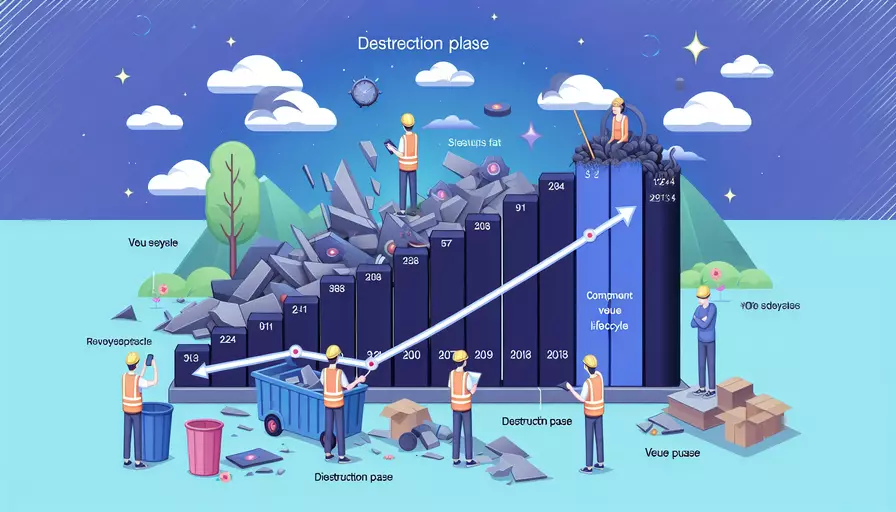
Vue实例会在以下情况下被销毁:1、调用实例的$destroy方法,2、Vue组件从父组件中被移除,3、路由切换导致组件被卸载。在这些情况下,Vue实例会触发相应的生命周期钩子函数,如beforeDestroy和destroyed。接下来我们将详细描述这些情况。
一、调用实例的`$destroy`方法
Vue实例有一个内置的方法$destroy,可以手动销毁实例。这在某些需要手动管理组件生命周期的复杂应用中非常有用。
步骤:
- 调用
$destroy方法:const vm = new Vue({// options
});
vm.$destroy();
- 触发生命周期钩子:在调用
$destroy方法后,实例会依次触发beforeDestroy和destroyed钩子。 - 清理绑定事件:Vue会自动清理与实例相关的所有指令和事件监听器。
示例:
const app = new Vue({
data: {
message: 'Hello World'
},
beforeDestroy() {
console.log('Instance is about to be destroyed');
},
destroyed() {
console.log('Instance has been destroyed');
}
});
app.$destroy();
二、Vue组件从父组件中被移除
当一个Vue组件被从父组件中移除时(例如通过条件渲染v-if或列表渲染v-for),Vue会自动销毁该组件实例。
步骤:
- 条件渲染/列表渲染:
<div v-if="showComponent"><child-component></child-component>
</div>
- 更改条件:
new Vue({data: {
showComponent: true
},
methods: {
toggleComponent() {
this.showComponent = !this.showComponent;
}
}
});
- 触发生命周期钩子:当
showComponent变为false,child-component会被销毁,触发beforeDestroy和destroyed钩子。
示例:
<template>
<div>
<button @click="toggleComponent">Toggle Component</button>
<child-component v-if="showComponent"></child-component>
</div>
</template>
<script>
export default {
data() {
return {
showComponent: true
};
},
methods: {
toggleComponent() {
this.showComponent = !this.showComponent;
}
}
};
Vue.component('child-component', {
template: '<div>Child Component</div>',
beforeDestroy() {
console.log('Child component is about to be destroyed');
},
destroyed() {
console.log('Child component has been destroyed');
}
});
</script>
三、路由切换导致组件被卸载
在使用Vue Router时,路由切换会导致不再匹配当前路由的组件被卸载。这是一个常见的情景,特别是在单页面应用(SPA)中。
步骤:
- 定义路由:
const routes = [{ path: '/home', component: HomeComponent },
{ path: '/about', component: AboutComponent }
];
- 初始化路由器:
const router = new VueRouter({ routes }); - 切换路由:
router.push('/about'); - 触发生命周期钩子:当路由切换时,不再匹配的组件会被销毁,触发
beforeDestroy和destroyed钩子。
示例:
const HomeComponent = {
template: '<div>Home</div>',
beforeDestroy() {
console.log('Home component is about to be destroyed');
},
destroyed() {
console.log('Home component has been destroyed');
}
};
const AboutComponent = {
template: '<div>About</div>'
};
const routes = [
{ path: '/home', component: HomeComponent },
{ path: '/about', component: AboutComponent }
];
const router = new VueRouter({ routes });
const app = new Vue({
router
}).$mount('#app');
router.push('/home');
setTimeout(() => {
router.push('/about');
}, 2000);
总结和建议
综上所述,Vue实例会在调用实例的$destroy方法、Vue组件从父组件中被移除以及路由切换导致组件被卸载时被销毁。1、调用$destroy方法可以手动销毁实例,2、条件渲染和列表渲染导致的组件移除,3、路由切换导致的组件卸载。
建议:
- 合理使用
$destroy:手动调用$destroy时,确保确实需要销毁实例以避免内存泄漏。 - 管理组件生命周期:在复杂应用中,了解并合理管理组件的生命周期钩子,确保组件被正确清理。
- 优化路由切换:在使用Vue Router时,注意组件的加载和卸载,避免不必要的性能开销。
通过理解和掌握Vue实例的销毁机制,我们可以更好地管理Vue应用中的组件生命周期,提升应用性能和稳定性。
相关问答FAQs:
1. 什么是Vue的销毁时机?
Vue的销毁时机是指Vue实例从内存中被彻底清除的时刻。在Vue应用中,当不再需要一个Vue实例时,需要手动销毁该实例,以释放内存并避免内存泄漏。
2. Vue实例是如何销毁的?
当需要销毁一个Vue实例时,可以使用Vue实例的$destroy方法来手动销毁。这个方法会触发Vue实例的beforeDestroy和destroyed生命周期钩子函数,可以在这两个钩子函数中执行一些清理工作,比如取消订阅、解绑事件等。
除了手动销毁,Vue实例也可以在某些情况下自动销毁。例如,当Vue实例所在的DOM元素被删除时,Vue会自动销毁该实例。
3. 什么时候应该销毁Vue实例?
一般情况下,当一个Vue实例不再需要使用时,应该手动销毁该实例。下面是一些常见的情况下应该考虑销毁Vue实例:
- 当一个组件被切换或不再需要显示时,应该销毁该组件对应的Vue实例。
- 当一个页面被切换或关闭时,应该销毁该页面对应的Vue实例。
- 当一个Vue实例所在的DOM元素被删除时,Vue会自动销毁该实例,但建议在不需要使用该实例时手动销毁,以避免潜在的内存泄漏问题。
总之,及时销毁不再使用的Vue实例是一种良好的编程习惯,可以提高应用的性能和内存利用率。
文章标题:vue什么时候销毁,发布者:飞飞,转载请注明出处:https://worktile.com/kb/p/3592698

 微信扫一扫
微信扫一扫  支付宝扫一扫
支付宝扫一扫 